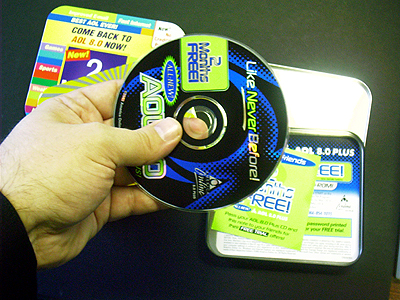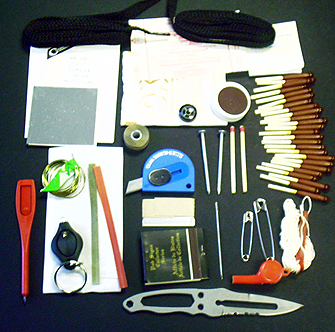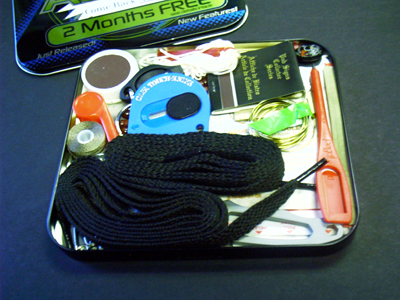its paid sponsors, whose products you need!
“Stay ‘unreasonable.’ If you
don’t like the solutions [available to you], come up with your
own.”
Dan Webre
The Martialist does not
constitute legal advice. It is for ENTERTAINMENT
PURPOSES ONLY.
Copyright © 2003-2004 Phil Elmore, all rights
reserved.
The AOL Survival Tin
By Phil Elmore (thanks to Don
Rearic)
“Get yourself an AOL tin,” Don
Rearic told me, “and run with the idea. Write an article about
it.”
We had been discussing the various survival
kits people put together in anticipating environmental or civil
adversity. Large kits obviously make sense for home and car use, but the
need for smaller, portable survival kits remains. This is particularly
true for those people (such as the thousands of stranded New Yorkers who
walked out of New York City during the summer blackout that affected much of
Northeast America) who may be caught away from home and without a
vehicle.
The more compact the kit, the better, provided
it still contains useful items. There are commercial
survival tins, homemade kits made from Altoid or Whitman Sampler tins, and
similar kits tucked away in a variety of plastic or metal containers.
One of the best tins for a compact, convenient survival kit arrives regularly
and unsolicited in the mail of countless people everyday. It’s free,
too.
I am speaking, of course, of the tins in which
AOL CDs are mailed. Like many people, I have no use for the constant
barrage of questionably coded AOL software, but the metal tins are hard to
resist. Don’t throw them away and don’t recycle them. Instead,
throw away the CD (or use it as a coaster, for all I care) and save the tins
for use as survival kit containers.

The beauty of the AOL tin, besides subverting
annoying junkmail for constructive purposes (and besides the fact that it’s
free) is that it is remarkably flat. A packed AOL tin will fit above a
car visor, in the pocket of a car seat or door, in the CD pockets of a
briefcase or travel bag, and inside a zippered schedule planner. While
it is broader than other tins, the AOL tin can be slipped many places those
thicker tins cannot. Its mundane appearance helps disguise its purpose,
too, though our aim is not to create a “secret” survival cache.
At Don Rearic’s suggestion I stocked my AOL tin
with a variety of items, some of which were salvaged from a commercial
tin. Other items I purchased specifically for the kit (such as the
varnish-covered, waterproof “lifeboat” matches), while still others came
from a variety of retail and discount sources.

The AOL survival tin, emptied of its
contents.
The kit contains items that would be useful,
conceivably, in a wide array of emergency situations. It includes the
following:
-
A ball-point pen
-
A printed guide to survival in the
wilderness -
Scrap paper
-
Folded strips of duct tape
-
A razor-knife and cardboard-covered
razorblade -
Twist-ties
-
Needle and thread
-
Safety pins
-
Emergency whistle
-
String/fishing line
-
Fish hooks
-
Nails
-
A matchbook, conventional matches, and
waterproof matches -
A striker for the matches
-
A small, bright, Photon
Microlight -
A small compass
-
Copper wire
-
Shoelaces
-
Signal mirror
-
Bullion powder
-
Alcohol swabs
-
Adhesive bandages
-
A small fixed-blade knife
There are some redundant items in the kit, but
that’s because I believe in having multiple options for important
things. The striker for the matches is actually the cover from the tube
in which the lifeboat matches were shipped. The fixed-blade knife is an
inexpensive “neck knife” I selected because it is very thin and
light and because one of my shoelaces could be used to wrap the handle for
more grip stability. (The holes in the knife could be used to lash it to
a stick to make an expedient spear, too.) I have not included tablets of
painkiller or water purifier, but these could be included wrapped in separate
plastic bags and clearly labeled. (Do NOT confuse them, EVER.)
All of these things fit neatly into the tin
when it is carefully packed. The whole unit can be secured with large,
heavy rubber bands and could be further sealed with duct tape or electrical
tape if necessary. The benefit of using rubber bands is that, hey, you
have rubber bands if you need them. (Make sure you use the thick, heavy
kind, rather than light rubber bands of dubious utility.)

AOL is practically throwing these tins at you,
at least if you live in the United States, so make a small pile of them and
start brainstorming things you might need or want in an emergency.
“Dollar stores” are great places to find useful items, as is the
camping and outdoors section of a discount store like Wal*Mart.
It doesn’t take a lot of money or effort to put something together on which
you can depend in the future.
Don’t wait until you need it to prepare a
portable survival
kit. Plan ahead and you’ll be grateful you did.
